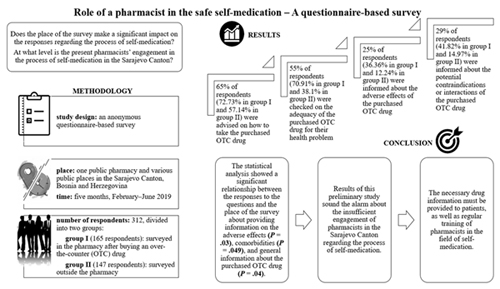Role of a Pharmacist in the Safe Self-medication – A Questionnaire-based Survey
Selma Škrbo
University of Sarajevo, Faculty of Pharmacy, Zmaja od Bosne 8, 71000 Sarajevo, Bosnia and Herzegovina.
Semir Mehović
Public Institution Apoteke Sarajevo, Kranjčevićeva 29, 71000 Sarajevo, Bosnia and Herzegovina.
Naida Omerović *
University of Sarajevo, Faculty of Pharmacy, Zmaja od Bosne 8, 71000 Sarajevo, Bosnia and Herzegovina.
Anela Hadžifejzović Trnka
Amsal Pharmaceuticals D.O.O., Igmanska 38, 71320 Vogošća, Bosnia and Herzegovina.
Nermina Žiga Smajić
University of Sarajevo, Faculty of Pharmacy, Zmaja od Bosne 8, 71000 Sarajevo, Bosnia and Herzegovina.
Belma Pehlivanović
University of Sarajevo, Faculty of Pharmacy, Zmaja od Bosne 8, 71000 Sarajevo, Bosnia and Herzegovina.
Dina Lagumdžija
University of Sarajevo, Faculty of Pharmacy, Zmaja od Bosne 8, 71000 Sarajevo, Bosnia and Herzegovina.
*Author to whom correspondence should be addressed.
Abstract
Aims: This study aimed to investigate whether the place of the survey makes a significant impact on the responses regarding the process of self-medication, as well as the present pharmacists’ engagement in this process in the Sarajevo Canton.
Study Design: An anonymous questionnaire-based survey.
Place and Duration of Study: One public pharmacy and various public places in the Sarajevo Canton, Bosnia and Herzegovina, for five months, February–June 2019.
Methodology: A total of 312 respondents was included. The first group (165 respondents) was surveyed in the pharmacy after buying an over-the-counter (OTC) drug, and the second group (147 respondents) was surveyed outside the pharmacy.
Results: Pharmacists instructed 65% of respondents (72.73% in the first group and 57.14% in the second group) on how to take the purchased OTC drug and checked whether 55% of respondents (70.91% in the first group and 38.1% in the second group) bought an appropriate drug for their health problem. Only 25% of respondents (36.36% in the first group and 12.24% in the second group) was informed about the adverse effects, whereas 29% of respondents (41.82% in the first group and 14.97% in the second group) was informed about the potential contraindications or interactions of the purchased OTC drug. The statistical analysis showed a significant relationship between the responses to the questions and the place of the survey about providing information on the adverse effects (P = .03), comorbidities (P = .049), and general information about the purchased OTC drug (P = .04).
Conclusion: In the Sarajevo Canton, pharmacists should be more actively involved in the process of self-medication and provide the necessary advice to patients consuming OTC drugs. Further research is needed so general conclusions could be drawn.

Keywords: self-medication, over-the-counter drug, safety, pharmacist
